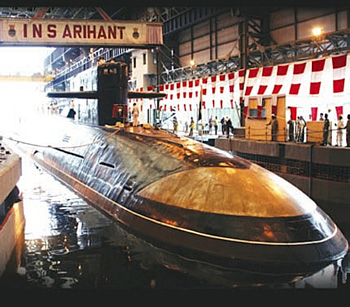INDIAN ARMED FORCES CHIEFS ON
OUR RELENTLESS AND FOCUSED PUBLISHING EFFORTS

SP Guide Publications puts forth a well compiled articulation of issues, pursuits and accomplishments of the Indian Army, over the years

I am confident that SP Guide Publications would continue to inform, inspire and influence.

My compliments to SP Guide Publications for informative and credible reportage on contemporary aerospace issues over the past six decades.
Indian Boomer in Service This Year?
By SP's Special Correspondent
The last year has been a tremendous one for the Arihant programme. 2013 kicked off splendidly with the successful underwater launch of the B05 submarine launched missile from the Bay of Bengal in January. The B05 will be the shorter range surface-to-surface weapon deployed by the Arihant. Noting the achievement, DRDO had said, “The missile launched from a pontoon, was tested for the full range and met all the mission objectives. All the parameters of the vehicle were monitored by the radar all through the trajectory and terminal events have taken place exactly as expected.” Sources say integration of the weapon system for further tests, including submarine tests is under way, with a first test later this year.
In August 2013, Arihant’s 83MW pressurized water reactor went critical, clearing the submarine platform to leave its dock and prepare for sea trials. Over the last six months, the submarine has been undergoing harbour and systems test, including full power trials. It was a big day in the Indian scientific establishment. Prime Minister had noted, “Today’s development represents a giant stride in the progress of our indigenous technological capabilities. It is testimony to the ability of our scientists, technologists and defence personnel to work together for mastering complex technologies in the service of our nation’s security. I look forward to the early commissioning of the INS Arihant.”
The Arihant programme, which envisages a total of three submarines of the class, is a fine example of partnership between the Defence Research and Development Organisation (DRDO), Indian Navy and private industry. With design and development help from Russia, the vessel has taken its time, but entering the final lap before it enters service, the Navy may feel justifiably proud of an indigenous effort for such a critical strategic capability.
The Russian Akula-II class INS Chakra nuclear-powered attack submarine entered service with the Indian Navy in April 2012. In the last two years, the vessel has proved to be a formidable presence in the Indian Ocean region, providing the Navy with a capability that has become indispensable. India is in the process of firming up the modalities to lease a second Akula-II submarine from Russia for a period of 10 years.With two Akulas, the Indian Navy will have an unpredecented force projection capability in its area of responsibility. The Chakra is providing the Indian Navy with valuable training capabilities to refresh procedures in anticipation of the Arihant and a second Akula-II. As reported in SP’s ShowNews for Day-1, the Indian Navy’s submarine arm could do with a whole lot of work.
In many ways, India’s nuclear submarine programme has happened in reverse. The country continues to build foreign technology conventional attack submarines, but the first indigenous boat will be the most complicated submarine type of all — a nuclear-powered ballistic missile platform. While the two following boats will also be SSBNs, there has been a loud call for an indigenous nuclear-powered attack submarine. At this stage, the DRDO’s Naval Materials Research Lab (NMRL) is developing a fuel-cell based air independent propulsion (AIP) plug for the 5th and 6th Scorpene off the Mazagon Dock Limited production line. The DRDO and Naval Architects are not, however, formally creating a nuclear-powered attack submarine design.





